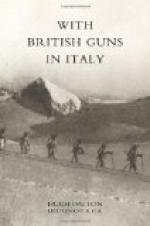THE CONQUEST OF THE BAINSIZZA PLATEAU
The Italian advance on the Middle Isonzo in the early days of the August offensive reached a depth of six miles on a front of eleven miles. The Italians had swept across the Bainsizza Plateau, and had gained observation and command, though not possession, of the Valley of Chiapovano, the main Austrian line of communication and supply in this sector. This advance and the resumption of the war of movement raised, for the moment, tremendous expectations, which were destined, alas, to die away without fulfilment.
The passage of the Isonzo, here a deep cleft in the mountains, from Plava to above Canale, had been accomplished by the combined skill and valour of Infantry, Artillery and Engineers. The preliminary work of the Engineers in roadmaking on the western side of the river had been, as always, worthy of the highest praise. A great mass of bridging material had had to be accumulated in the valley, alongside camouflaged roads. The Austrians must have been on their guard, but it seems probable that they did not expect a big attack to be made here. For they were fully conscious of the natural strength of their positions.
First to cross the river on the night of the attack were boats carrying Engineers and detachments of Arditi. As they crossed, the river gorge was full of mist and they were not detected. But when the work of bridging began, and sounds of hammering and the dragging of planks into position could be clearly heard, suddenly all along the further bank the Austrian machine guns began to spit fire, and red rockets went up calling for the Artillery barrage. Many boats were hit and sank, and the Bridging Detachments suffered severe casualties. One bridge, half built, was set on fire, and one could see dark shadows, lit up by the glare amid the darkness, darting forward to extinguish the flames. Fourteen bridges were thrown across under heavy fire, and, as the Infantry began to cross, Platoon after Platoon, the Austrian Machine Gunners fired at the sound of their footsteps, and many Italians fell, especially officers leading their men. But the crossing went on and, when dawn broke, the attackers had a firm footing on the left bank of the river. They swept round the flanks of those machine guns which had not yet been put out of action, and making use of the subterranean passages which the enemy had pierced in the cliffs for sheltered communication between the higher and the lower levels of the mountain, began to pour forth upon the crest of the ridge which overlooks the river. Then, as the advance continued, the Austrian right wing above Canale gave way in confusion and the Italians pressed forward on to the Bainsizza Plateau.




